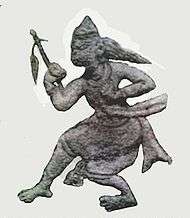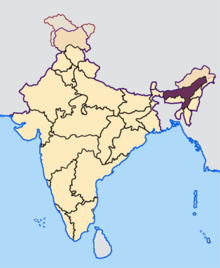Chutiya people
| Total population | |
|---|---|
| 2 – 2.5 million[1] | |
| Regions with significant populations | |
| Predominantly in Upper, North Bank and Central Assam; urban areas across Assam, India; 7,000 - 9,000 settled across India and abroad | |
| Languages | |
| Assamese(Predominant) | |
| Religion | |
| Related ethnic groups | |
|
The Chutiya people (also spelt Chutia and Sutiya; /ˈsʊðiːjɑː/) are an Indigenous Assamese people or an ethnic group originating in the Indian state of Assam and are the descendants of the Sino-Tibetan family of Mongoloid stock. The earliest recorded history about the Chutiyas is found in the Assamese chronicle, which names Assambhina as the first Chutiya king to have dwelt on the banks of the Brahmaputra in the 7th century A.D.[3] The Chutiya people through the Chutiya dynasty formed their kingdom in the present Indian states of Assam and Arunachal Pradesh and reigned from 1187 to 1673.
They are a physically diverse ethnic group of mixed East Asian and Indo Aryan appearance and make one of the major and earliest section of the plain inhabitants of Assam to have migrated from Southern China, predominantly from the present Tibet and Sichuan. The seat of the Chutiyas when they were in the ascendant, appears to have been about Lakhimpur and the back of the Subansiri River. They hold all the countries to the north of the Brahmaputra as far down as Sonitpur. They spoke a language of Tibeto-Burman origin but overtime started speaking Assamese language and adopted Hinduism. Chutiyas along with Koch Rajbongshi, Keot/Kaibarta, Ahom and various other Indigenous Assamese communities are sometimes referred to as semi-Hinduised caste from an aboriginal tribe.
The Chutiya community are recognised as an Other Backward Class by the Government of India and are an ethnic Assamese-speaking group. Today, most of them reside in Upper Assam districs and a fair amount are found in lower Assam districts of Kamrup and Kamrup metro. The 2011 census report estimated their population as 2,600,000 (26 lakhs).
Etymology
There are many views to the etymology of the word "Chutia". Historians believe that the term is derived from chut or "mountain top", their original place of habitation (after arriving from Sinchuan), before settling down in the plains of Upper Assam.[4]
Origin
The Chutiyas are semi-Hinduised people who had a large kingdom in upper Assam. They are generally believed from their language to be closely related to Kacharis.[5] They seem to have largely intermarried with the Ahoms, so that the latter have a subdivision called 'Chutiya'. The Chutiyas have sections calling themselves 'Ahoms'. The Chutiyas display prominent Caucasoid features due to the absorption of the Pal dynasty by the Chutiya kings in the middle of the 13th century and due this inclusion they show close genetic affinities with some Caucasoid groups mainly the Brahmin and Kayastha castes of Assam. They are now chiefly found in the upper Assam districts side by side with the Ahoms.
Chutiya rule (1187-1673)

The Chutiya Kingdom was established by Birpal in 1187 on the northern bank of the river Brahmaputra. The kingdom absorbed the ancient Pal dynasty and reigned for over 400 years in northeastern Assam and areas of present-day Arunachal Pradesh, with the capital at Sadiya. The kingdom controlled the entire region of present Assam districts of Lakhimpur, Dhemaji, Tinsukia and parts of Jorhat, Dibrugarh, Sonitpur.
It was the dominant kingdom in upper Assam till the 16th century in which it expanded from Parshuram Kund in the east to Vishwanath in the west and had absorbed many local communities and tribes. Most illustrious of the Chutiya kings was Gaurinarayan (Ratnadhwajpal), son of Birpal. He brought many other Chutiya groups into his kingdom. In 1224 Ratnadhwajpal defeated Bhadrasena, the king of Swetagiri. Then he went on to subjugate Nyayapal and marched toward Kamatapur, where he formed an alliance with the Kamata ruler by marrying a princess. Then he marched to Dhaka, and made friends with the Gauda ruler.
The hostilities with the Ahoms began when the Chutiya Kingdom expanded to the south and during which Ahom king, Sutuphaa, was killed by the Chutiya king during a friendly negotiation.This conflict triggered a number of battles between the two sides, which saw great lost of men and money. The simmering dispute often flared till 1523 when the Ahoms struck the Chutiya Kingdom in its weakest state, they finally took Sadiya and killed the then king Nityapal. The Ahoms established their rule by instituting the position of Sadiyakhowa Gohain, the governor in charge of Sadiya. But the Chutiya had dispersed to frontier regions, and continued raids against the Ahoms. It finally ended in 1673, when the Chutiyas fall under the domination of the Ahoms.
Language
The original language of the Chutiyas belong to the Tibeto-Burman language group, also known by the same name i.e. Chutiya. Although, the language is no longer spoken, it is well preserved by the Deuri people or the priestly section of the group.Template:SfnPrakash
As per some historians, Chutiya language had evolved a lot over the years. The language first arrived with Chutiyas from Sinchuan province of China with an ancient Chinese script. Then, over the centuries it mixed with other Bodo-Kachari languages to such an extent that it fell under Tibeto-Burman language. It was probably written in the Deodhai script at that time.
Later, after the advent of Prakrit in the Brahmaputra valley, the language evolved and assimilated with the Prakrit language. This was probably the time when the first form of Assamese originated in Upper Assam. The old Chutiya language was preserved by the Deori priestly section.
When the Ahoms arrived in the 13th century, they found the Chutiya language to be a version of localised Prakrit with a Prakrit script. According to Ahom buranjis, this form of Assamese along with the original Chutiya language were the only languages to have a writing script when they arrived.
This form of Assamese was then adopted by the Ahom courts and spread throughout the kingdom. They used this form combined with Tai influence to form the Gargayan Assamese used in later Buranjis. The modern written form of Assamese is mostly influenced by the Gargaya branch of Assamese.[6]
Religion
In the early medieval period, the Chutiyas followed a religion closely related to Buddhism i.e. Bon before adopting Hinduism. During the rule of the Chutiya dynasty, they worshipped various forms of Kali with the help of their tribal priests, Deuris. Their favourite form of worshipping this deity was that of Kesai Khaiti. A crude form of Hinduism became the state religion at a very early time and influence of tantric form of Shaktism was felt in the royal court. Human sacrifices of criminals was offered to tutelary Goddess, Khesai Khati and pilgrims from region far more remote i.e. Tibet and China brought their offerings as a token of faith for Tantricism.[2]
In modern times, the majority of Chutiyas are followers of Hinduism and Ekasarana Dharma, a pantheistic religion founded and propagated by Srimanta Sankardeva during the 15th century in Assam.
Subdivisions
Historically, Chutiyas have been divided into five important groups:[7]
- Hindu Chutiya
- Ahom Chutiya
- Borahi Chutiya
- Miri Chutiya
- Deuri Chutiya
The Hindu Chutiya represented the majority of the population and were formed by the marriage of the Chutiyas with the immigrants of the Pala dynasty. The Ahom Chutiya were formed by the intermarriage between the Chutiyas and the Ahoms and also by having different position in administration of the Ahom kingdom as seen with Momai Tamuli Borbarua and Lachit Borphukan. Similarly, some Miris and Borahis were absorbed into the community.
The Deuri are at present recognised as one of the plain tribes of Assam.
Notes
Citations
- ↑ "Chutiyas to shun Cong".
- 1 2 Prakash 2007, pp. 911–916.
- ↑ Prakash 2007, pp. 912.
- ↑ Momin, Mignonette; Mawlong, Cecile A.; Qādrī, Fuz̤ail Aḥmad (2004). Society and Economy in North-East India. Regency Publications. p. 47. ISBN 9788189233402.
two main views on the origin of the Chutiyas: (a) that the Chutiyas were so called because they had originally occupied the chut or mountaintop ...
- ↑ Endle, Sidney (1911). The Kacharis. Macmillan And Co. p. 29. Retrieved 7 October 2018.
- ↑ Yasmin Saikia in her book Assam and India: Fragmented Memories mentioned Sadiya, capital of the Chutiya kingdom to be one of the two important centers of development for the Assamese language.(Saikia 2004, pp. 6-7)
- ↑ (Guptajit Pathak:82)
Bibliography
- Prakash, Col. Ved (2007), Encyclopedia of North East India.Vol.2, Atlantic Publishers & Dist.
- Waddell, L.A (1999). Tribes of the Brahmaputra Valley : A Contribution Of Their Physical Type and Affinities. Concept Publishing Company.
